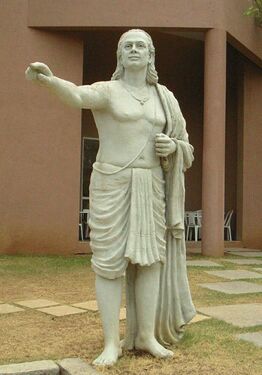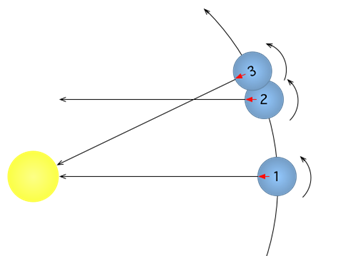Sidereal day of Aryabhata
Activity objectives
Background
Indian astronomy has a history that spans several thousand years but it is the period around the 5th – 6th century CE where it is said to have reached its greatest heights. This is when the most famous Indian astronomer, Aryabhata (476–550 CE), flourished. His greatest mathematical and astronomical work, the Aryabhatiya, represented the pinnacle of astronomical knowledge at the time.
- Learn about the difference between sidereal and solar days
- Gain an idea of ancient Indian astronomy
- Use Stellarium to determine the duration of a sidereal day
Background
Indian astronomy has a history that spans several thousand years but it is the period around the 5th – 6th century CE where it is said to have reached its greatest heights. This is when the most famous Indian astronomer, Aryabhata (476–550 CE), flourished. His greatest mathematical and astronomical work, the Aryabhatiya, represented the pinnacle of astronomical knowledge at the time.
Aryabhata: Taken from https://en.wikipedia.org/wiki/Aryabhata#/media/File:2064_aryabhata-crp.jpg
Amongst Aryabhata’s most important astronomical achievements was the correct interpretation of the apparent daily motion of the stars, which he attributed to the rotation of the Earth about its axis rather than the rotation of the celestial sphere itself, the correct scientific interpretation of eclipses, and the accurate determination of the duration of a sidereal day.
A sidereal day is the time it takes for the Earth to completed one revolution about is axis with respect to the fixed stars. A solar day on the other hand, is the time it takes for the Sun to return to our local meridian (due South for the Northern hemisphere and due North for the southern hemisphere). The solar day is what we are more used to (more precisely the mean solar day), and it lasts 24 hours. The sidereal day is a little shorter and the following figure illustrates why.
Amongst Aryabhata’s most important astronomical achievements was the correct interpretation of the apparent daily motion of the stars, which he attributed to the rotation of the Earth about its axis rather than the rotation of the celestial sphere itself, the correct scientific interpretation of eclipses, and the accurate determination of the duration of a sidereal day.
A sidereal day is the time it takes for the Earth to completed one revolution about is axis with respect to the fixed stars. A solar day on the other hand, is the time it takes for the Sun to return to our local meridian (due South for the Northern hemisphere and due North for the southern hemisphere). The solar day is what we are more used to (more precisely the mean solar day), and it lasts 24 hours. The sidereal day is a little shorter and the following figure illustrates why.
Solar and sidereal day
At point 1, the sun lies at our local meridian. At point 2, the Earth has completed one revolution with respect to the fixed stars but because of its motion relative to the Sun, the Sun has still not reached our local meridian. In order to achieve this (at point 3), the Earth must spin for a little longer than 24 hours. So, the solar day is slightly longer than the sidereal day and this is due to our motion around the Sun.
Implementation in Stellarium
Start Stellarium and in the Date/Time Window, set the date to: 500 / 01 / 01. This is around the time when Aryabhata lived.
Next, set the location in the Location Window to Patna in India. This is where Aryabhata lived for part of his life.
Set the local time to 10:30 pm and locate the star Canopus (you can obviously use any star to perform this). Determine the exact time when Canopus crosses the local meridian (i.e. when it is exactly South with an azimuth of 180 degrees).
Next, set the date to: 500 / 01 / 02 (i.e. exactly a day later) and find the time when Canopus has an azimuth of 180 degrees.
Use the difference in the two times to estimate the duration of a sidereal day.
Aryabhata determined the sidereal day to be 23 hours, 56 minutes, and 4.1 seconds.
Compare the value you obtained to that of the great Indian astronomer.
At point 1, the sun lies at our local meridian. At point 2, the Earth has completed one revolution with respect to the fixed stars but because of its motion relative to the Sun, the Sun has still not reached our local meridian. In order to achieve this (at point 3), the Earth must spin for a little longer than 24 hours. So, the solar day is slightly longer than the sidereal day and this is due to our motion around the Sun.
Implementation in Stellarium
Start Stellarium and in the Date/Time Window, set the date to: 500 / 01 / 01. This is around the time when Aryabhata lived.
Next, set the location in the Location Window to Patna in India. This is where Aryabhata lived for part of his life.
Set the local time to 10:30 pm and locate the star Canopus (you can obviously use any star to perform this). Determine the exact time when Canopus crosses the local meridian (i.e. when it is exactly South with an azimuth of 180 degrees).
Next, set the date to: 500 / 01 / 02 (i.e. exactly a day later) and find the time when Canopus has an azimuth of 180 degrees.
Use the difference in the two times to estimate the duration of a sidereal day.
Aryabhata determined the sidereal day to be 23 hours, 56 minutes, and 4.1 seconds.
Compare the value you obtained to that of the great Indian astronomer.


